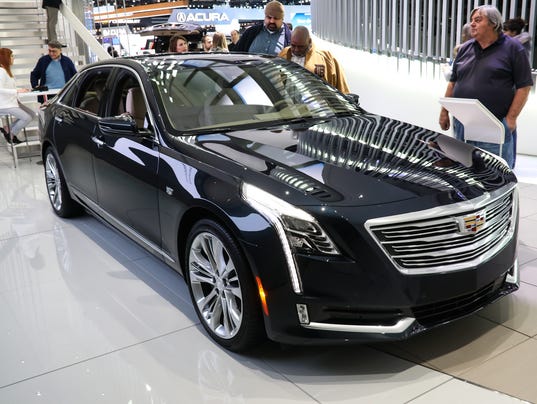CLOSE![]()
Dozens of companies in California are reportedly now test self-driving cars, with Samsung being the latest corporation to get permission from the state’s Department of Motor Vehicles. Wochit

Buy Photo
The Cadillac Super Cruise CT6 has a hands-free driving system for the freeway seen at the North American International Auto Show in Detroit on Thursday, Jan. 25, 2018.
(Photo: Kimberly P. Mitchell, Detroit Free Press)Buy Photo
(This column is based on comments Mark Phelan made to the Lambda Car Club.)
The dust had barely settled on Detroit auto show headlines including the rediscovery of the “Bullitt” Mustang, the Detroit debut of the fastest and most powerful Chevrolet Corvette ever, and Ford’s promise to deliver an all-electric sports car when some generally smart people began lamenting the end of exciting cars, and excitement about driving.
They’re convinced autonomous vehicles that meet strict emissions limits cannot also inspire passion.
Prime among the doubters is Bob Lutz, a brilliant and accomplished executive who was probably responsible for the creation of more great vehicles than I’ve sat in. Speaking at a “Why Driving Matters” panel coinciding with a week of classic car auctions in Arizona, Lutz predicted human driving will be outlawed in major cities in 10 years, when private vehicles are replaced by anonymous transportation pods that deliver you like a UPS package, then move on to the next number in their queue.
I beg to differ.
Saying autonomy is incompatible with great design and exciting products is like a lumberjack saying the days of great building design ended when we stopped living in log cabins.
Read more:
]]>
]]>
Frank Lloyd Wright, Eero Saarinen and Frank Gehry might disagree, and I believe the people who are engineering and designing autonomous vehicles today will again prove that you should never bet against human ingenuity.
Self-driving cars are closer than most of us think, but the days when you can no longer take the wheel and enjoy a day’s drive are farther away.
CLOSE![]()
Cadillac reinvents driving with system that steers car for long distances on highways
I love road trips, and I’ve never enjoyed one more than 2,200 miles last fall in a Cadillac CT6 that drove itself more than 1,800 miles of the total. I thought I’d be bored behind the wheel of a self-driving car, but I was relaxed and able to enjoy the scenery more than usual. It was like a luxury train compartment, with better seats and Bose audio I cranked and sang with at the top of my lungs. I also got better fuel economy than driving myself, because the car had a steadier, smoother control of the throttle than my right foot.
]]>
]]>
The CT6’s Super Cruise system is limited to restricted-access highways, but vehicles that can drive themselves around neighborhoods and communities are coming.
Think about what that will mean to the elderly and people with limited mobility: More independence; an extended envelope for living on your own terms. It makes the benefits of mass transit available to people who live in suburbs, small towns and cities that don’t have an infrastructure of street cars and subways.
That doesn’t mean the end of driving, or the end of automotive design. Beautiful design – inside and out – will be even more important when your focus doesn’t have to be on the speedometer, the fuel gauge and the windshield.
And driving? There’s very little overlap between the romance of the open road and crawling through a 5:45 p.m. traffic snarl.
Driving is drudgery a lot of the time, but people don’t want to relinquish the possibility of taking the wheel, Autotrader senior analyst Michelle Krebs says.
“People want driverless performance when they’re commuting and maybe on long road trips, but they want the option to drive themselves.”
The sweet spot for autonomous vehicles is what engineers call level 4 autonomy, Krebs adds. That means vehicles that can drive themselves but still have controls for the driver. Level 5 is a vehicle with no controls for the driver.
]]>
The best comparison is autopilot in aircraft. It’s been around for years, is virtually foolproof and can guide a plane from point A to point B without human intervention. It can even land and take off.
Despite that, every aircraft has windows in the cockpit, controls and human crew to use them.
The idea that autonomous cars will be windowless boxes with no more controls than an elevator just doesn’t stack up to the only basis for comparison we’ve got: Planes can fly themselves today, but they still have pilots and controls, and there are still plenty of people who fly for pleasure.
In 2040, IHS Markit forecasts, only 25% of global auto sales will be totally autonomous vehicles with no driver controls.
I’d be shocked if that’s not the case with cars for a long time into the future.
Contact Mark Phelan: mmphelan@freepress.com or 313-222-6731. Follow him on Twitter @mark_phelan.
Read or Share this story: http://on.freep.com/2scdwYX
